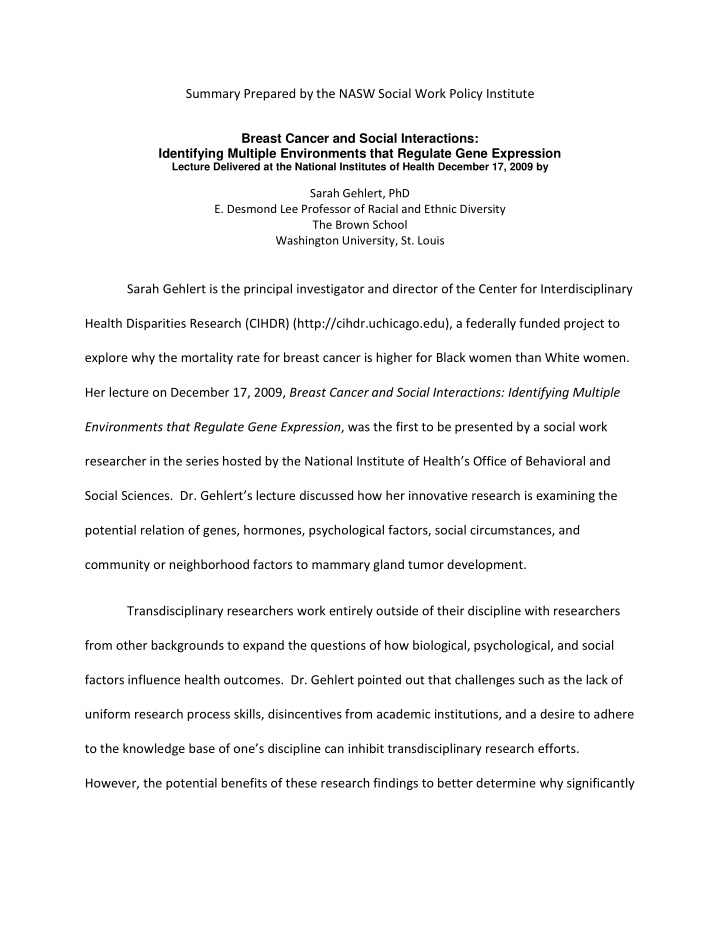



Summary Prepared by the NASW Social Work Policy Institute Breast Cancer and Social Interactions: Identifying Multiple Environments that Regulate Gene Expression Lecture Delivered at the National Institutes of Health December 17, 2009 by Sarah Gehlert, PhD E. Desmond Lee Professor of Racial and Ethnic Diversity The Brown School Washington University, St. Louis Sarah Gehlert is the principal investigator and director of the Center for Interdisciplinary Health Disparities Research (CIHDR) (http://cihdr.uchicago.edu), a federally funded project to explore why the mortality rate for breast cancer is higher for Black women than White women. Her lecture on December 17, 2009, Breast Cancer and Social Interactions: Identifying Multiple Environments that Regulate Gene Expression , was the first to be presented by a social work researcher in the series hosted by the National Institute of Health’s Office of Behavioral and Social Sciences. Dr. Gehlert’s lecture discussed how her innovative research is examining the potential relation of genes, hormones, psychological factors, social circumstances, and community or neighborhood factors to mammary gland tumor development. Transdisciplinary researchers work entirely outside of their discipline with researchers from other backgrounds to expand the questions of how biological, psychological, and social factors influence health outcomes. Dr. Gehlert pointed out that challenges such as the lack of uniform research process skills, disincentives from academic institutions, and a desire to adhere to the knowledge base of one’s discipline can inhibit transdisciplinary research efforts. However, the potential benefits of these research findings to better determine why significantly
more Black women are dying from breast cancer and how this health disparity may be treated and prevented far outweighs the research challenges. The CIHDR is comprised of social workers, psychologists, physicians, oncologists, biologists, and even civil engineers working on four intertwined research projects. These projects establish the connection of social circumstances to biological outcomes of breast cancer in Black women by reviewing animal and human models at the genetic, hormonal, psychological, social, environmental, and population levels. Project 1 examines the development of mammary tumors and the ovarian function of group-living rats that have been socially isolated. As group-living rats were isolated at various points in their lifespan, they showed signs of increased stress-hormone levels, hypervigilance and did not explore or seek out food in their cage. Even after returning to the group, these isolated rats’ interactions were impaired and stress levels remained elevated. Subsequently, these isolated rats were 84 times more likely to have mammary tumors than the non-isolated rats, showing a link between elevated stress and isolation and tumor development. Project 2 explores the exposures prior to diagnoses, social environment, and psychological risk factors of Black breast cancer patients in the South Side of Chicago and Nigeria. Further, researchers construct a biological profile for each patient from collected tumor tissue samples. Results show similarities between BRCA-1 related breast cancers (a mutation of the BRCA-1 gene that leads to early onset breast cancer) and the tumors of Black women. Using the McClintock model developed from project 1 that
identifies an increase in tumor growth as a result of social isolation, it was determined that social factors, such as depression, assault, and loneliness cause a constant increase of stress hormones, which leads to the alteration of pathways that lead to BCRA-1 mutations and early onset of breast cancer. Project 3 uses a community-based participatory research (CBPR) model to explore the views of Black women in South Side Chicago being treated for breast cancer. The study also tests the validity of the McClintock model by examining the neighborhood and community factors, living situations, social connectedness, behavioral responses, and biological and health outcomes of the patients to determine any correlations. Results show that women who are exposed to more negative factors resulting in social isolation also have increased stress hormone levels and other biological factors that facilitate tumor growth. The next steps for this project will be to test the effects of neighborhood level interventions on biological outcomes of tumor growth. Project 4 evaluates the rate of mammary tumor growth, responses to chemotherapy, and chemoprevention in relation to varying stress levels using two types of rats. Current results support the hypothesis that stress from social isolation increases the rate of mammary tumor growth, increases a tumor’s resistance to chemotherapy, and decreases the susceptibility of mammary glands to chemoprevention in both types of rats. Future projects aim to evaluate the outcomes of social and biological interventions to determine the downstream effect of social interventions on health outcomes at the biological
level. For more information or to view the lecture, visit the OBSSR Seminar Series web site at: http://obssr.od.nih.gov/news_and_events/lectures_and_seminars/BSSR_lecture_series/seminars.aspx
Recommend
More recommend